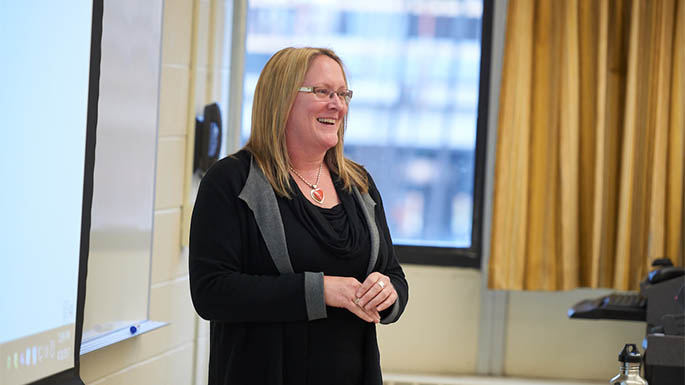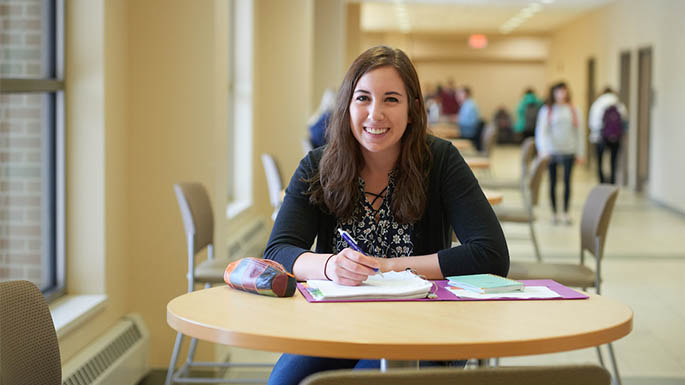Posted 10:03 a.m. Thursday, May 4, 2017

Research expands student experience in environment, language classes.
Research expands student experience in environment, language classes
Nature tells a story. Take a careful look at tree rings, ice cores or lake sediment, and you can travel back in time — hundreds to thousands of years. UWL Assistant Professor of Geography and Earth Science Joan Bunbury guided her students on that path during a course this semester, Past Environmental Change. What was special about the course was the way Bunbury wove teaching and research together. [caption id="attachment_48719" align="aligncenter" width="685"] Joan Bunbury teaches Past Environmental Change. She embedded research into the curriculum with a course-embedded undergraduate research (CEUR) grant through UWL’s Center for Advancing Teaching and Learning.[/caption]
Eleven of her students were among the many UWL students presenting at the 20th Annual Celebration of Student Research and Creativity Thursday, April 20. Bunbury’s classroom research was funded by a course-embedded undergraduate research (CEUR) grant through UWL’s Center for Advancing Teaching and Learning. Typically, students prepare a report at the conclusion of their research. But, if the course is taught in the spring, presenting at the Celebration of Student Research is also an interesting option, notes Scott Cooper, UWL director of Undergraduate Research and Creativity.
Lake sediment links to past
In Bunbury’s class, students conducted research using a lake sediment core she collected in 2014 near the archaeological site of Aztalan, the northern-most site of the Mississippian people, located near what is today Lake Mills, Wisconsin. The group settled Aztalan and it flourished for about 300 years, but around 1300 AD, the Mississippian people left abruptly. Bunbury’s research uses lake sediment to understand the role past climate may have played in their departure.
In Bunbury’s class, students used a variety of methods to analyze the lake sediment core sample and interpret what that might have meant for the end of Aztalan. UWL student Rachel Kromrey and her group used x-ray diffraction to determine the mineralogy of the sediment during the time Aztalan was inhabited, which would shed light on whether a change in climate led to the abandonment of the site.
Kromrey says research improved her experience in the course. “I was able to apply what I learned in lecture to a real-world scenario and it improved my understanding of what lake sediments can tell us about past environments,” she says.
At the same time, students are contributing to research Bunbury ultimately plans to publish.
Putting modern language theory into practice
Claire Mitchell, assistant professor of Modern Languages, also wove research into her Introduction to Second Language Acquisition class. A total of 13 of her students presented at the Celebration of Student Research and Creativity.
In the course, her students read literature on a topic of their choice related to language acquisition, and then identified research gaps. They created a research project based around the gap.
“Introduction to Second Language Acquisition can typically be very theory heavy,” notes Mitchell. “This helps students put theory into practice.”
UWL student Paige Kudlik and her research partner looked into content-based instruction, an up-and-coming language teaching approach where a foreign language serves as a vehicle for learning subjects such as math, science or social studies. Past research has evaluated the teaching approach based on student test scores and teacher’s perspectives. But Kudlik and her research partner didn’t find past research on students’ perspectives on the effectiveness of the teaching strategy, particularly at the college level.
[caption id="attachment_48721" align="aligncenter" width="685"]
Joan Bunbury teaches Past Environmental Change. She embedded research into the curriculum with a course-embedded undergraduate research (CEUR) grant through UWL’s Center for Advancing Teaching and Learning.[/caption]
Eleven of her students were among the many UWL students presenting at the 20th Annual Celebration of Student Research and Creativity Thursday, April 20. Bunbury’s classroom research was funded by a course-embedded undergraduate research (CEUR) grant through UWL’s Center for Advancing Teaching and Learning. Typically, students prepare a report at the conclusion of their research. But, if the course is taught in the spring, presenting at the Celebration of Student Research is also an interesting option, notes Scott Cooper, UWL director of Undergraduate Research and Creativity.
Lake sediment links to past
In Bunbury’s class, students conducted research using a lake sediment core she collected in 2014 near the archaeological site of Aztalan, the northern-most site of the Mississippian people, located near what is today Lake Mills, Wisconsin. The group settled Aztalan and it flourished for about 300 years, but around 1300 AD, the Mississippian people left abruptly. Bunbury’s research uses lake sediment to understand the role past climate may have played in their departure.
In Bunbury’s class, students used a variety of methods to analyze the lake sediment core sample and interpret what that might have meant for the end of Aztalan. UWL student Rachel Kromrey and her group used x-ray diffraction to determine the mineralogy of the sediment during the time Aztalan was inhabited, which would shed light on whether a change in climate led to the abandonment of the site.
Kromrey says research improved her experience in the course. “I was able to apply what I learned in lecture to a real-world scenario and it improved my understanding of what lake sediments can tell us about past environments,” she says.
At the same time, students are contributing to research Bunbury ultimately plans to publish.
Putting modern language theory into practice
Claire Mitchell, assistant professor of Modern Languages, also wove research into her Introduction to Second Language Acquisition class. A total of 13 of her students presented at the Celebration of Student Research and Creativity.
In the course, her students read literature on a topic of their choice related to language acquisition, and then identified research gaps. They created a research project based around the gap.
“Introduction to Second Language Acquisition can typically be very theory heavy,” notes Mitchell. “This helps students put theory into practice.”
UWL student Paige Kudlik and her research partner looked into content-based instruction, an up-and-coming language teaching approach where a foreign language serves as a vehicle for learning subjects such as math, science or social studies. Past research has evaluated the teaching approach based on student test scores and teacher’s perspectives. But Kudlik and her research partner didn’t find past research on students’ perspectives on the effectiveness of the teaching strategy, particularly at the college level.
[caption id="attachment_48721" align="aligncenter" width="685"] As a future teacher, UWL student Paige Kudlik had personal interest in her research project in a modern languages class. Kudlik and her research partner looked into the effectiveness of content-based instruction, an up-and-coming language teaching approach.[/caption]
For their research project, they surveyed UWL students in a Spanish 330 class who were studying “Spanish in the Professional World.” Their results show that the UWL students felt more confident in their ability to communicate in a professional way after learning a foreign language using content-based instruction. In fact, student responses reflected they were meeting the American Council on the Teaching of Foreign Languages’ five standards to achieve communicative proficiency in foreign language courses: culture, communications, connections, comparisons and communities.
Kudlik says she is already using content-based instruction as a student teacher at Northwoods International School in La Crosse where she teaches math and science in Spanish. Her research in Mitchell’s class adds to the increasing data supporting the effectiveness of content-based instruction. That’s personally important to Kudlik who is excited to use the method as a future teacher.
She says applying theory from class to real-life scenarios through research made the modern language class content more comprehensible. It also fueled her ambitions to continue doing research.
As a future teacher, UWL student Paige Kudlik had personal interest in her research project in a modern languages class. Kudlik and her research partner looked into the effectiveness of content-based instruction, an up-and-coming language teaching approach.[/caption]
For their research project, they surveyed UWL students in a Spanish 330 class who were studying “Spanish in the Professional World.” Their results show that the UWL students felt more confident in their ability to communicate in a professional way after learning a foreign language using content-based instruction. In fact, student responses reflected they were meeting the American Council on the Teaching of Foreign Languages’ five standards to achieve communicative proficiency in foreign language courses: culture, communications, connections, comparisons and communities.
Kudlik says she is already using content-based instruction as a student teacher at Northwoods International School in La Crosse where she teaches math and science in Spanish. Her research in Mitchell’s class adds to the increasing data supporting the effectiveness of content-based instruction. That’s personally important to Kudlik who is excited to use the method as a future teacher.
She says applying theory from class to real-life scenarios through research made the modern language class content more comprehensible. It also fueled her ambitions to continue doing research.